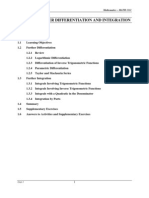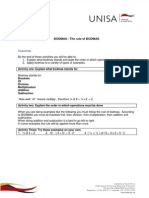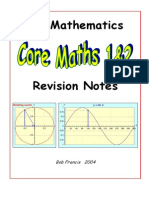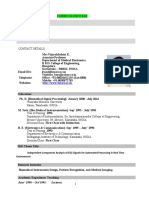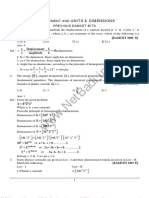0 ratings0% found this document useful (0 votes)
45 viewsWeek 6 - Lecture Notes Maxima and Minima: Dy DX
1. The document discusses techniques of calculus for finding maximum and minimum values of functions, which have numerous applications in business contexts like finding maximum profit.
2. It provides criteria for identifying maxima and minima points of a function based on the first and second derivatives. Examples are included of applying these concepts to maximize sales and minimize average cost.
3. The document also covers concepts related to revenue and costs like marginal revenue, average cost, marginal cost, and how profit is maximized when marginal revenue equals marginal cost. Examples are provided of applying these calculus techniques to business optimization problems.
Uploaded by
Farheen NawaziCopyright
© © All Rights Reserved
Available Formats
Download as PDF, TXT or read online on Scribd
0 ratings0% found this document useful (0 votes)
45 viewsWeek 6 - Lecture Notes Maxima and Minima: Dy DX
1. The document discusses techniques of calculus for finding maximum and minimum values of functions, which have numerous applications in business contexts like finding maximum profit.
2. It provides criteria for identifying maxima and minima points of a function based on the first and second derivatives. Examples are included of applying these concepts to maximize sales and minimize average cost.
3. The document also covers concepts related to revenue and costs like marginal revenue, average cost, marginal cost, and how profit is maximized when marginal revenue equals marginal cost. Examples are provided of applying these calculus techniques to business optimization problems.
Uploaded by
Farheen NawaziCopyright
© © All Rights Reserved
Available Formats
Download as PDF, TXT or read online on Scribd
You are on page 1/ 13
Week 6 – Lecture notes
Maxima and Minima
In this session I have discussed how techniques
of calculus is applied to find the maximum and
minimum values of a function.
To model the real world problems we often
express physical quantities in terms of
variables. Then functions are used to define the
ways in which these variable changes.
Decision makers will be more interested in
finding the maximum profit, minimum loss or
minimum amount of material to make a
particular product.
There are numerous applications in which it is
preferred to find the maximum or minimum
value of a particular quantity.
Criteria for Maxima and Minima
dy d2y
If 0 at a point and if 2
0 then that
dx dx
point must be maximum point for the function.
dy d2y
If 0 at a point and if 2
0 then that
dx dx
point must be minimum point for the function.
A talcum powder manufacturer has determined
the commercial advertisement on the media has
an appreciable impact on the sales of new
powder. It is estimated that the number of
pouches P ( x) , sold and the expenditure x (in
thousands of rupees) are related by
P( x) 160 x x 2 300 . Find the amount that
must be spent on media so as to maximize sales.
First derivative:
dP
160 2 x
dx
dP
P attains extrema when 0
dx
160 2 x 0
x 80
Is it maximum?
d 2P
2
2 0
dx
P attains maxima at x 80
Sales is maximized when 80 (in thousands of
rupees) spend on media.
The cost function of a firm is
C ( x) 24,000 180 x 0.50 x 2 where C is the
total cost for x units. A decision maker is
interested to calculate what level of output the
firm will minimize its average cost.
First derivative:
dC
180 1.0 x
dx
dC
P attains extrema when 0
dx
180 1.0 x 0
x 180
Is it minimum?
d 2C
2
1 0
dx
C attains minima at x 180
180 units of output is one that minimizes
average cost.
Application of Calculus in Business
Differentiation in business refers to the act of
marketing a particular product or service in a
way that makes it stand out against other
products or services. In this session I illustrate
just a few of the many applications of
derivatives to business. In this session I have
discussed how techniques of calculus is applied
to business.
The total cost of producing and marketing x
units of a product depend upon the number of
units of x.
The relationship between the output (assumed
by x) of a product and the total cost (assumed
by C) of a product is called as total cost
function.
Total cost of producing x units of a product
consists of two components:
a) Fixed cost which is independent of the
amount of output, that is, fixed cost
remains the same at all levels of output.
For example: rent, interest and so on.
b) Variable cost is the sum of all costs that
are dependent on the level of productions.
For example: raw materials, labour etc.,
If the total cost function C 500 4 x
Where 500 represent the fixed cost or
overhead (the total cost function when x 0 )
If C is the cost of producing x items then the
average cost (AC) of producing x items is
C
given by AC .
x
Average cost represents the cost per unit of
the output.
Marginal cost (MC) is the additional cost
incurred in producing one more unit of output
and it is given by
dC
MC
dx
Marginal cost measures the rate of increase of
total cost with respect to small increase in
production.
Relationship between average and marginal
cost:
Average cost is minimum at the value of x for
which average cost equals marginal cost.
The cost function of a firm is given by
C ( x) x3 3x 8 . Find the average cost and
also find marginal cost when x 6 units.
C ( x) x3 3 x 8
Average cost, AC
x x
8
x 3
2
x
dC d 3
Marginal cost, MC ( x 3x 8)
dx dx
3x 2 3
Marginal cost when x 6 units is
3(6)2 3 105
The manufacturing cost of a product consists of
Rs. 6000 as overheads, material cost Rs.6 per
x2
unit and labour cost Rs. for x units
60
produced. Find how many units must be
produced so that the average cost is minimum?
Total cost C is given by
C= overheads + material cost +labour cost
x2
Therefore, C 6000 6 x where x units
60
are produced.
C 6000 x
Average cost AC 6
x x 60
Average cost attains minimum,
d
( AC ) 0
dx
d 6000 x
6 0
dx x 60
6000 1
0
x2 60
This implies, x 600
Is AC minimum?
d2 12000
2
( AC )
dx x3
d2 12000
At x 600 , 2
( AC ) 3
0
dx x
Hence AC is minimum when 600 units
produced.
Problems for practice
1.The cost function of a firm is given by
2 2 3
C ( x) 5000 1000 x 500 x x . Find
3
the marginal cost and also find the average
cost function.
2.The manufacturing cost of an item consists
of Rs. 1000 as overheads, material cost Rs.2
x2
per item and labour cost Rs. for x items
90
produced. Find how many items must be
produced so that the average cost is
minimum?
The money which flows into a company from
either giving service or selling a goods is called
as revenue.
Total revenue is the total money received by
selling x items of the product at a price p per
unit.
Total revenue = price per unit (p)×quantity sold (x)
If R is the revenue from the sale of x items then
the average revenue (AR) from selling x items
R
is given by AR .
x
Average revenue represents revenue per unit.
Marginal revenue (MR) is the additional
revenue earned by selling one more unit of a
product and it is given by
dR
MR
dx
Marginal revenue (MR) measures the rate of
increase of total revenue with respect to
quantity demanded.
Profit (or the net revenue) of a company is the
difference between the total revenue and total
cost.
That is, P( x) R( x) C ( x)
Marginal profit (MP) is the additional profit
from selling one more unit of a product and it
is given by
dP
MP
dx
Profit function will be maximum if marginal
revenue equals the marginal cost.
A manufacturer determines that the profit P (in
rupees) derived from selling x units of an item
is given by
P( x) 0.0002 x3 20 x
Find the marginal profit for a production level
of 50 units.
Profit P( x) 0.0002 x3 20 x
dP
Marginal profit MP
dx
d
(0.0002 x3 20 x)
dx
0.0006 x 2 20
Now a marginal profit for a production level of
50 units is 0.0006(50)2 20 21.5Rs
A head phone manufacturer that in order to sell
x units of new head phone, the price per unit in
Rs, must be P( x) 10000 x
The manufacturer also determines that the total
cost of producing x units is given by
C ( x) 30000 200 x
a. Find the total revenue R(x).
b.Find the marginal revenue.
c. Find the total profit P(x).
d.How many units must the company produce
and sell in order to maximize profit?
a. R(x) = Total Revenue
= (Number of units). (Price per unit)
x.P
10000x x 2
dR
b.Marginal revenue MR
dx
10000 2x
c. Total profit P(x) = Total Revenue–Total
cost
R( x) C ( x)
(10000 x x 2 ) (30000 200 x)
x 2 9800 x 30000
dP
d.P attains maxima when 0
dx
d
( x 2 9800 x 30000) 0
dx
2 x 9800 0
This implies, x 4900
Is it maximum?
d 2P
2
2 0
dx
P attains maxima at x 4900
Therefore, profit is maximized when 4900 units
are produced and sold.
You might also like
- HACC416 or HSPAC 411 - TUTORIAL QUESTIONS - 064542No ratings yetHACC416 or HSPAC 411 - TUTORIAL QUESTIONS - 06454242 pages
- Documents - CAAH2013 - MBA 2 Acc Dec Making Workbook Jan 2013 PDF100% (1)Documents - CAAH2013 - MBA 2 Acc Dec Making Workbook Jan 2013 PDF96 pages
- Unit 2: Accounting Concepts and Trial BalanceNo ratings yetUnit 2: Accounting Concepts and Trial Balance12 pages
- Study Unit 5: Calculus Chapter 6: Sections 6.1, 6.2.1, 6.3.1 Chapter 8: Section 8.1, 8.2 and 8.5No ratings yetStudy Unit 5: Calculus Chapter 6: Sections 6.1, 6.2.1, 6.3.1 Chapter 8: Section 8.1, 8.2 and 8.519 pages
- Tutorial Letter 102/3/2018: Introductory Financial AccountingNo ratings yetTutorial Letter 102/3/2018: Introductory Financial Accounting84 pages
- Dsc1520 Assignment 3 Possible Solutions: Royal AcademyNo ratings yetDsc1520 Assignment 3 Possible Solutions: Royal Academy16 pages
- Introduction To Financial Accounting Notes Lecture Notes Lectures 1 10 Part 1 CompleetNo ratings yetIntroduction To Financial Accounting Notes Lecture Notes Lectures 1 10 Part 1 Compleet17 pages
- Chap III Theory of Consumer's BehaviourNo ratings yetChap III Theory of Consumer's Behaviour42 pages
- Joint Cost Allocation-Illustrative ProblemsNo ratings yetJoint Cost Allocation-Illustrative Problems4 pages
- Financial Accounting Summer 2011 Chap 3 Homework - SP 3100% (4)Financial Accounting Summer 2011 Chap 3 Homework - SP 313 pages
- Chapter 2 Accounting Concepts and Principles PDFNo ratings yetChapter 2 Accounting Concepts and Principles PDF12 pages
- Module 2 - The Basic Theory Using Demand and SupplyNo ratings yetModule 2 - The Basic Theory Using Demand and Supply20 pages
- Cost Management Test Questions and Suggested SolutionsNo ratings yetCost Management Test Questions and Suggested Solutions63 pages
- Solutions To Text Problems: Chapter 6: Quick QuizzesNo ratings yetSolutions To Text Problems: Chapter 6: Quick Quizzes60 pages
- BAC814: Management Accounting: Discussion QuestionsNo ratings yetBAC814: Management Accounting: Discussion Questions3 pages
- Company Accounts: - in Law, Company' Is Termed As An Entity Which Is Formed andNo ratings yetCompany Accounts: - in Law, Company' Is Termed As An Entity Which Is Formed and9 pages
- Income and Expenditures Account by HM RanaNo ratings yetIncome and Expenditures Account by HM Rana36 pages
- Solution To QN 6 (PG 135) : Calculation of Overhead Absorption RatesNo ratings yetSolution To QN 6 (PG 135) : Calculation of Overhead Absorption Rates10 pages
- Mathematics 1St First Order Linear Differential Equations 2Nd Second Order Linear Differential Equations Laplace Fourier Bessel MathematicsFrom EverandMathematics 1St First Order Linear Differential Equations 2Nd Second Order Linear Differential Equations Laplace Fourier Bessel MathematicsNo ratings yet
- Solutions Manual to Accompany Introduction to Quantitative Methods in Business: with Applications Using Microsoft Office ExcelFrom EverandSolutions Manual to Accompany Introduction to Quantitative Methods in Business: with Applications Using Microsoft Office ExcelNo ratings yet
- Week 12 - Lecture Notes Special MatricesNo ratings yetWeek 12 - Lecture Notes Special Matrices25 pages
- Module 5 Programming Foundation and Exploratory Data AnalysisNo ratings yetModule 5 Programming Foundation and Exploratory Data Analysis152 pages
- Contact For The Course: - Instructor: Dr. Kauser Ahmed PNo ratings yetContact For The Course: - Instructor: Dr. Kauser Ahmed P54 pages
- Download Complete The adventures of an IT leader Austin PDF for All Chapters100% (1)Download Complete The adventures of an IT leader Austin PDF for All Chapters55 pages
- DBM CSC Form No. 1 Position Description Forms BlankNo ratings yetDBM CSC Form No. 1 Position Description Forms Blank1 page
- Gaussian Noise & All Filters (Matlab Code)100% (10)Gaussian Noise & All Filters (Matlab Code)4 pages
- Universidad Nacional Abierta y A Distancia - UNAD Curso: INGLÉS B1+ Código: 9000No ratings yetUniversidad Nacional Abierta y A Distancia - UNAD Curso: INGLÉS B1+ Código: 90006 pages
- Updated Course Material 5 in Math 2 For 2nd Semester 2021 2022 For DistributionNo ratings yetUpdated Course Material 5 in Math 2 For 2nd Semester 2021 2022 For Distribution14 pages
- Yu Hua - On Brothers and Chaotic Aesthetics, (Chinese Literature Today, Spring 2011)No ratings yetYu Hua - On Brothers and Chaotic Aesthetics, (Chinese Literature Today, Spring 2011)6 pages
- Team Teaching: Exploring The Curriculum: Compostela Valley State CollegeNo ratings yetTeam Teaching: Exploring The Curriculum: Compostela Valley State College22 pages
- Medical Center Map - Directions - Hotel Information PDFNo ratings yetMedical Center Map - Directions - Hotel Information PDF3 pages
- Million-Day Gregorian-Julian Calendar - Notes100% (1)Million-Day Gregorian-Julian Calendar - Notes10 pages
- HACC416 or HSPAC 411 - TUTORIAL QUESTIONS - 064542HACC416 or HSPAC 411 - TUTORIAL QUESTIONS - 064542
- Documents - CAAH2013 - MBA 2 Acc Dec Making Workbook Jan 2013 PDFDocuments - CAAH2013 - MBA 2 Acc Dec Making Workbook Jan 2013 PDF
- Study Unit 5: Calculus Chapter 6: Sections 6.1, 6.2.1, 6.3.1 Chapter 8: Section 8.1, 8.2 and 8.5Study Unit 5: Calculus Chapter 6: Sections 6.1, 6.2.1, 6.3.1 Chapter 8: Section 8.1, 8.2 and 8.5
- Tutorial Letter 102/3/2018: Introductory Financial AccountingTutorial Letter 102/3/2018: Introductory Financial Accounting
- Dsc1520 Assignment 3 Possible Solutions: Royal AcademyDsc1520 Assignment 3 Possible Solutions: Royal Academy
- Introduction To Financial Accounting Notes Lecture Notes Lectures 1 10 Part 1 CompleetIntroduction To Financial Accounting Notes Lecture Notes Lectures 1 10 Part 1 Compleet
- Financial Accounting Summer 2011 Chap 3 Homework - SP 3Financial Accounting Summer 2011 Chap 3 Homework - SP 3
- Module 2 - The Basic Theory Using Demand and SupplyModule 2 - The Basic Theory Using Demand and Supply
- Cost Management Test Questions and Suggested SolutionsCost Management Test Questions and Suggested Solutions
- Solutions To Text Problems: Chapter 6: Quick QuizzesSolutions To Text Problems: Chapter 6: Quick Quizzes
- BAC814: Management Accounting: Discussion QuestionsBAC814: Management Accounting: Discussion Questions
- Company Accounts: - in Law, Company' Is Termed As An Entity Which Is Formed andCompany Accounts: - in Law, Company' Is Termed As An Entity Which Is Formed and
- Solution To QN 6 (PG 135) : Calculation of Overhead Absorption RatesSolution To QN 6 (PG 135) : Calculation of Overhead Absorption Rates
- Mathematics 1St First Order Linear Differential Equations 2Nd Second Order Linear Differential Equations Laplace Fourier Bessel MathematicsFrom EverandMathematics 1St First Order Linear Differential Equations 2Nd Second Order Linear Differential Equations Laplace Fourier Bessel Mathematics
- Solutions Manual to Accompany Introduction to Quantitative Methods in Business: with Applications Using Microsoft Office ExcelFrom EverandSolutions Manual to Accompany Introduction to Quantitative Methods in Business: with Applications Using Microsoft Office Excel
- Module 5 Programming Foundation and Exploratory Data AnalysisModule 5 Programming Foundation and Exploratory Data Analysis
- Contact For The Course: - Instructor: Dr. Kauser Ahmed PContact For The Course: - Instructor: Dr. Kauser Ahmed P
- Download Complete The adventures of an IT leader Austin PDF for All ChaptersDownload Complete The adventures of an IT leader Austin PDF for All Chapters
- DBM CSC Form No. 1 Position Description Forms BlankDBM CSC Form No. 1 Position Description Forms Blank
- Universidad Nacional Abierta y A Distancia - UNAD Curso: INGLÉS B1+ Código: 9000Universidad Nacional Abierta y A Distancia - UNAD Curso: INGLÉS B1+ Código: 9000
- Updated Course Material 5 in Math 2 For 2nd Semester 2021 2022 For DistributionUpdated Course Material 5 in Math 2 For 2nd Semester 2021 2022 For Distribution
- Yu Hua - On Brothers and Chaotic Aesthetics, (Chinese Literature Today, Spring 2011)Yu Hua - On Brothers and Chaotic Aesthetics, (Chinese Literature Today, Spring 2011)
- Team Teaching: Exploring The Curriculum: Compostela Valley State CollegeTeam Teaching: Exploring The Curriculum: Compostela Valley State College
- Medical Center Map - Directions - Hotel Information PDFMedical Center Map - Directions - Hotel Information PDF






















